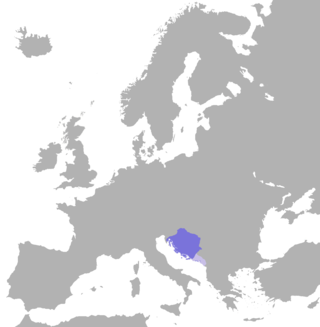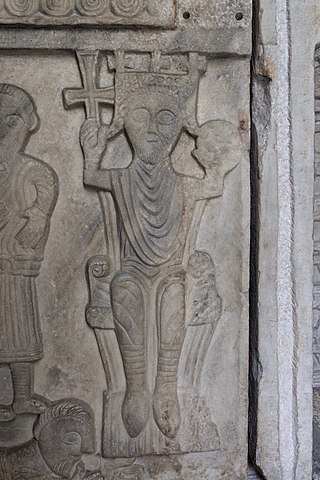
At the time of the Roman Empire, the area of modern Croatia comprised two Roman provinces, Pannonia and Dalmatia. After the collapse of the Western Roman Empire in the 5th century, the area was subjugated by the Ostrogoths for 50 years, before being incorporated into the Byzantine Empire.

The Kingdom of Croatia entered a personal union with the Kingdom of Hungary in 1102, after a period of rule of kings from the Trpimirović and Svetoslavić dynasties and a succession crisis following the death of king Demetrius Zvonimir. With the coronation of King Coloman of Hungary as "King of Croatia and Dalmatia" in 1102 in Biograd, the realm passed to the Árpád dynasty until 1301, when the (male) line of the dynasty died out. Then, kings from the Capetian House of Anjou, who were also cognatic descendants of the Árpád kings, ruled the kingdoms. Later centuries were characterized by conflicts with the Mongols, who sacked Zagreb in 1242, competition with Venice for control over Dalmatian coastal cities, and internal warfare among Croatian nobility. Various individuals emerged during the period, such as Paul I Šubić of Bribir, who was representing the most powerful Croatian dynasty at the time, the Šubić noble family. These powerful individuals were on occasion able to de facto secure great deal of independence for their fiefdoms. The Ottoman incursion into Europe in the 16th century significantly reduced Croatian territories and left the country weak and divided. After the death of Louis II in 1526 during the Battle of Mohács and a brief period of dynastic dispute, both crowns passed to the Austrian House of Habsburg, and the realms became part of the Habsburg monarchy.
Ban was the title of local rulers or office holders, similar to viceroy, used in several states in Central and Southeastern Europe between the 7th century and the 20th century. The most common examples have been found in Croatia. They often ruled as the king's governmental representatives, supreme military commanders and judges, and in 18th century Croatia, even chief government officials.

Bosnian Cyrillic, widely known as Bosančica is a variant of the Cyrillic alphabet that originated in medieval Bosnia. The term was coined at the end of the 19th century by Ćiro Truhelka. It was widely used in modern-day Bosnia and Herzegovina and the bordering areas of modern-day Croatia. Its name in Bosnian-Croatian-Serbian is Bosančica and Bosanica the latter of which can be translated as Bosnian script. Serb scholars call it Serbian script, Serbian–Bosnian script, Bosnian–Serb Cyrillic, as part of variant of Serbian Cyrillic and the term "bosančica" according to them is Austro-Hungarian propaganda. Croat scholars also call it Croatian script, Croatian–Bosnian script, Bosnian–Croat Cyrillic, harvacko pismo, arvatica or Western Cyrillic. For other names of Bosnian Cyrillic, see below.

Petar Snačić was a feudal lord, notable for being one of the claimants of the Croatian throne between c. 1093 and 1097. It is assumed that he began as a ban serving under king Demetrius Zvonimir of Croatia and was then elected king by the Croatian feudal lords in 1093. Petar's seat of power was based in Knin. His rule was marked by a struggle for control of the country with Coloman of Hungary, dying at the Battle of Gvozd Mountain in 1097.

Peter Krešimir IV, called the Great was King of Dalmatia and Croatia from 1059 until his death in 1074 or 1075. He was the last great ruler of the Krešimirović branch of the Trpimirović dynasty.

The Kingdom of Croatia, or Croatian Kingdom, was a medieval kingdom in Southern Europe comprising most of what is today Croatia, as well as most of the modern-day Bosnia and Herzegovina. The Croatian Kingdom was ruled for part of its existence by ethnic dynasties, and the Kingdom existed as a sovereign state for nearly two centuries. Its existence was characterized by various conflicts and periods of peace or alliance with the Bulgarians, Byzantines, Hungarians, and competition with Venice for control over the eastern Adriatic coast. The goal of promoting the Croatian language in the religious service was initially introduced by the 10th century bishop Gregory of Nin, which resulted in a conflict with the Pope, later to be put down by him. In the second half of the 11th century Croatia managed to secure most coastal cities of Dalmatia with the collapse of Byzantine control over them. During this time the kingdom reached its peak under the rule of kings Peter Krešimir IV (1058–1074) and Demetrius Zvonimir (1075–1089).
Šokci are a South Slavic ethnic group native to historical regions of Baranya, Bačka, Slavonia and Syrmia. These regions today span eastern Croatia, southwestern Hungary, and northern Serbia. They primarily self-identify as a subgroup of Croats and therefore they are not considered a separate ethnicity in Croatia and elsewhere.

Demetrius Zvonimir was a King of Croatia and Dalmatia from 1075 or 1076 until his death in 1089. Zvonimir also served as Ban of Croatia (1064–1074), and was named Duke of Croatia in around 1075. His native name was Zvonimir, but adopted the forename Demetrius at his coronation.
Bošnjani, meaning Bosnians, is the name originating from the Middle Ages, used for the inhabitants of Bosnia. The name is used and can be found in Bosnian written monuments from that period, appearing in Venetian sources as earliest as 12th century, according to investigation of the relations between Bosnia and Venetia by historian Marko Šunjić, and other documents until at least early 16th century and the Ottoman conquest and power stabilization.

The Republic of Poljica or duchy was an autonomous community which existed in the late Middle Ages and the early modern period in central Dalmatia, near modern-day Omiš, Croatia.

The area of today's Visoko is considered to be a nucleus from where Bosnian statehood was developed in 10th century. The expanded valley of the river Bosna around today's Visoko was the biggest agriculture area in central Bosnia, so fertile ground around Visoko was ideal for development of early political center of Bosnian nobility.

Ban of Croatia was the title of local rulers or office holders and after 1102, viceroys of Croatia. From the earliest periods of the Croatian state, some provinces were ruled by bans as a ruler's representative (viceroy) and supreme military commander. In the 18th century, Croatian bans eventually became the chief government officials in Croatia.
The Battle of Bliska was fought in 1322 between the army of a coalition of several Croatian noblemen and Dalmatian coastal towns and the forces of Mladen II Šubić of Bribir, Ban of Croatia, and his allies. The battle resulted in the defeat of Mladen II, who lost his power.

The Kačić family was one of the most influential Croatian noble families, and was one of the Croatian "twelve noble tribes" described in the Pacta conventa and Supetar Cartulary. Historical sources refer to members of this family as nobles in the area of the Luka županija in the Zadar-Biograd hinterland, as the lords (knezes) of Omiš, and as the lords of the Makarska Riviera. Another prominent branch of the family, Kacsics, was part of the Hungarian nobility and from it branched many families including Szécsényi.

The Mogorović family was one of the twelve noble tribes of the Kingdom of Croatia, mentioned in the Pacta conventa and Supetar Cartulary. They were initially mentioned in the 12th and 14th centuries in the hinterland of Biograd na Moru and Zadar in Dalmatia, and since the 13th century in the region of Lika, where they branched into most prominently Disislavić noble family, besides being divided into other fourteen noble branches by 15th and 16th century. As experienced warriors, they actively participated in the Croatian–Ottoman wars. Direct descendants of the tribe live even today in Croatia.
Petar Crni was a Croatian nobleman, dignitary and Latin poet in the second half of the 11th century.
The twelve noble tribes of Croatia, also known as twelve noble families of Croatia, was a medieval institution of nobility, alliance, or narrow noble community in the Kingdom of Croatia, which can be traced back at least to the 14th century, while the first mention of the institution was in the Pacta conventa document, which is supposedly a later copy of the original from 1102. Regardless of possible earlier references, the first verifiable mention dates from 1350, while the last from 1459. It is considered that by socio-economic power it was composed of lower and middle nobility, which had a privilege of retain and use of heirdom, tax exemption, and limited military obligations to the king. The twelve tribes are Čudomirić, Gusić, Kačić, Kukar, Jamomet, Lasničić, Lapčan and Karinjan, Mogorović, Poletčić, Snačić, Šubić, and Tugomirić.
The Snačić family, sometimes called Svačić and Svadčić, was one of the twelve noble tribes of Croatia, mentioned in the Pacta conventa and Supetar Cartulary. Among the oldest known members of the family is Petar Snačić, who is very likely to have been the last Croatian king of Croatian descent.

The House of Talovac was a Croatian noble family, descending from the island of Korčula and reaching its peak in the 15th century in the Kingdom of Croatia, at that time in personal union with Hungary. The members of the family rose to high state, church or military offices, such as Ban (Viceroy) of Croatia and Dalmatia as well as Ban of Whole Slavonia, royal court chamberlain, bishop, župan and others.











